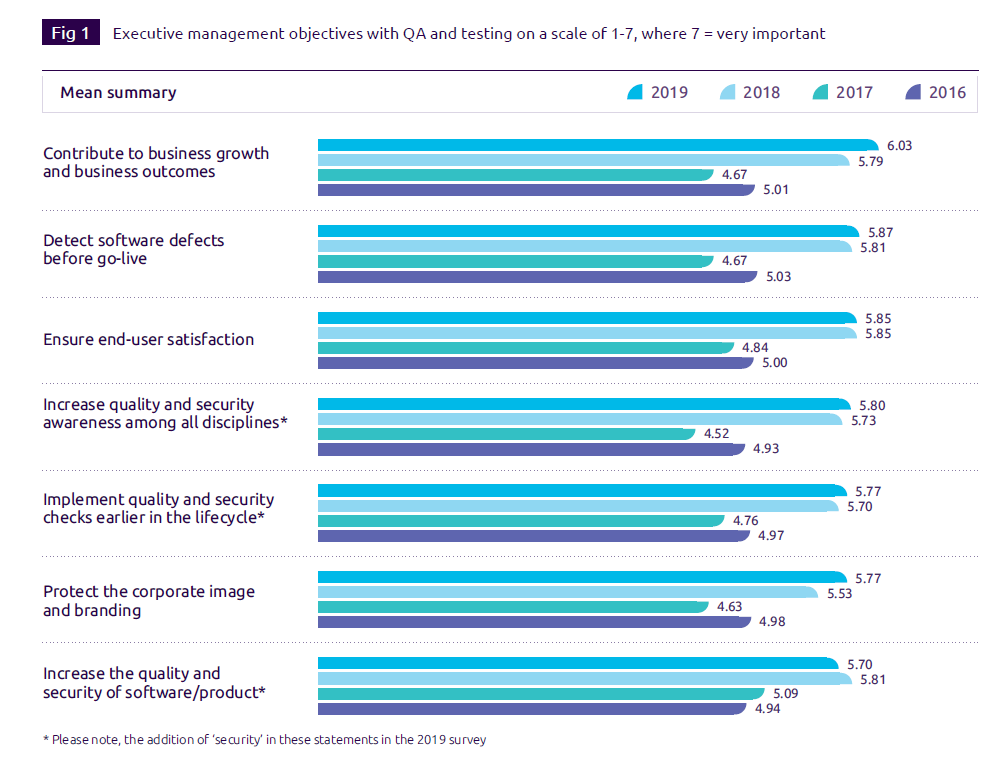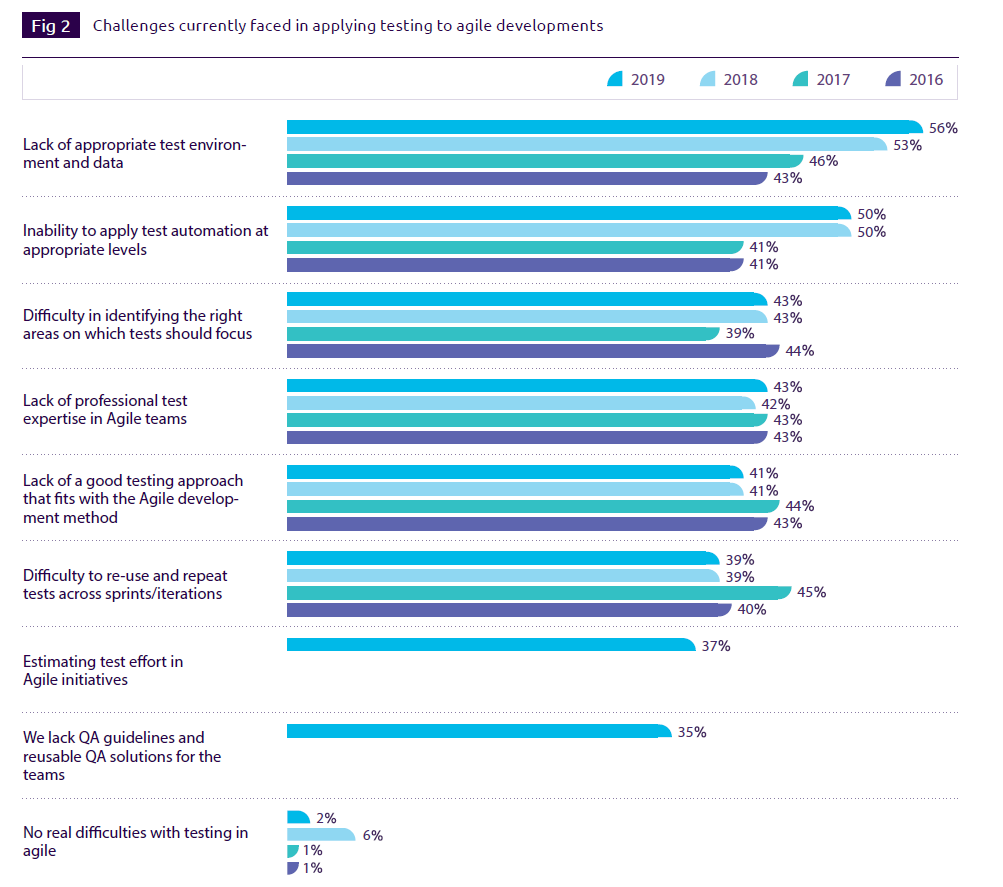03 September 2020
Software testing trends for 2019-2020: What the future holds for Quality Assurance

IT is one of those industries that notoriously changes – whatever was trending just a year ago, now might be considered outdated and replaced by something fresher. It’s no different with Quality Assurance. Fortunately, we don’t need to look into the crystal ball to predict the future of our industry – we’ve got a much better oracle. If you are trying to figure out what the future of software testing will look like, you should check out the “World Quality Report”. In this article, I’d like to highlight the most important software testing trends for 2019-2020 mentioned in the report, all together with the best practices recommendations. Let’s take a look at what’s new in testing technology trends…
About the World Quality Report
Whether you manage a QA team or are a client of a software house, it’s absolutely crucial to keep your eye on the development in accordance with the latest trends in software testing. The World Quality Report gives you a pretty good insight into current trends in software testing. According to the authors, “it discusses the trends shaping QA and testing today, along with recommendations for addressing tomorrow’s challenges.”
I’ve based this article on two editions of the report:
- WQR 2018-19 – insights from 1700 specialists from 32 countries and 10 different sectors.
- WQR 2019-20 – research findings from 1725 senior IT executives across 32 countries, divided into eight industry groups.
The first, and if you ask me – the most important – observation is that QA and software testing has come a long way. From being treated like a supporting act, Quality Assurance services grew to be the critical factor in both web and mobile development – from both business and customer satisfaction perspective.
In other words, QA is now being treated as a serious and inseparable part of software development.
What software testing trends for 2019-2020 were pointed out by the authors of the report? In this article, we’re going to focus on software testing objectives, the latest software testing technologies, test automation trends, artificial intelligence and machine learning, digital transformation in agile and security in software testing.
Troubles ahead? Worry not!
Business priorities and end-user satisfaction
Based on the 2018-2019 report, the top Quality Assurance and testing objective, for not only 2019 but the next years to come, is end-user satisfaction. The role of a QA engineer has evolved from finding defects to actually thinking as the end-user. Software testers need to focus more on customer goals rather than the particular functionality of an application that should be free of bugs.
“This indicates that QA and testing are increasingly aligned with business goals and the engineers should have a bigger picture in their minds.”
It’s not surprising that end-user satisfaction was marked as the priority goal. The rest of the key software testing trends for 2019 mentioned in a report eventually influence and enhance this one. In order to successfully achieve end-user satisfaction, you need to have highly-skilled QA engineers, who understand their roles and responsibilities and are accountable for the quality of the product they work on. This should be a part of a well-defined QA strategy as well as organisational culture.
And the 2019-20 report clearly reflects that. Tech leaders shifted their primary objective of Quality Assurance to growing their business and improving business outcomes not only by detecting software defects before they go-live but also by ensuring that they developed a useful product that adds value for the clients.
“Now more than ever, teams need to ensure the development projects on which they are embarked are aligned closely to the needs of the business, and also to the customers they serve. This means that a new way of working is required, in the form of a smart, connected and business-driven ecosystem.”

This trend isn’t shocking. At The Software House, we saw the first signs of such an end-user-centred and business-driven approach some time ago, and we’ve been working on adapting to the changes ever since. Our QA team strives to achieve a higher level by cooperating closely with our clients. All QA engineers attend in-house training, improving their skills and knowledge base, as well as researching and developing necessary testing tools (with emphasis on our TSH-original testing tool Kakunin – but we will talk about this later). I must shamelessly admit that, by looking at our five-star Clutch reviews complementing our high-quality products, as a Head of the QA department, I feel very proud!
Are you a tech manager in need of talented software developers and QA specialists? 👀
As the no. 1 software development company in Poland, we’re here to help you. Consult your project with our Quality Assurance experts during a free, 1-hour conultations.
Growth in adoption of Agile
With the increasing demand to deliver software faster and to be more responsive to the changes, many companies have moved towards Agile Software Development. The report states that the QA and testing function is changing as well: “Adoption to Agile & DevOps leads to the fragmentation of the QA department. QA engineers are part of the development teams rather than separate testing units.” [We don’t like to be called “testing units” anyway! 🙄] According to the report, this decentralization causes issues with establishing new technologies, best practices and common approach with creating test scenarios and test reports.
The results of the WQR 2019-20 only extend those findings:
“The testing and quality assurance industry is undergoing a significant shift, and in order to cope, executives and team leaders are doing all they can to ‘rewire’ their existing people as well as to hire new talent.“
How to deal with applying those software testing latest trends in your organisation? All you need to do is to define and supervise testing processes and quality standards across all teams and encourage all QA engineers to be accountable for implementing and following them in their projects.
How do we do this in TSH? We start from onboarding where everybody, including our new employees, discusses all important areas related to the QA activities. Beyond that, we constantly improve our skills by establishing recurring meetings with all QA team members and discuss improvements to the standards and processes in accordance with software testing trends.
Based on my experience in TSH, I can assure you that this approach works very well. We have already built a self-motivating team of QA/QAA engineers who are encouraged to constantly share their knowledge and work as a team, rather than jealously keeping useful tips to themselves. It immediately resulted in a massive customer satisfaction boost – because no matter the projects, we have the same good practices for releasing high-quality products only.
💡 Read more:
Test environments and test data approach
According to the 2018-19 report’s respondents, the lack of test environments and manual test data generation is a number-one challenge as far as the adoption of Agile development is concerned. It goes even further, as the second challenge – increasing the level of test automation – is connected with the first one.
“Those factors are the bottleneck towards greater QA and testing maturity” – we read in the WQR. The main recommendation is to invest in smart QA and testing platforms, like containerized test environments, open data projects and smart solutions for test data sampling.
As you can see in the graph below, nothing changed in the 2019-20 version of the report. The lack of an appropriate test environment and inability to apply test automation are still the top two challenges the Quality Assurance in the IT industry faces.

Containerized test environments bring a big value for testing since you don’t affect anyone else and are able to run automated tests that clean up all data or simply have new versions deployed for your specific tests. If you combine it with appropriate tools for generating test data automatically it speeds up testing activities a lot. Or you can move and anonymize production data – and guess what, we found a way to do that. We developed a smart open-source data-masking tool called Fogger that allows you to hide fragile information. It’s GDPR-friendly too!

Sometimes you just gotta face the risks...
Artificial Intelligence and the latest testing technologies
The 2018-19 report states that the growth of artificial intelligence has a big impact on QA activities and will continue to grow in the upcoming years. Authors noticed that AI will “enable companies to transform testing to a fully self-generating, self-running and self-adapting activity.” In order to achieve that, you need to reach proficiency in automation.
“The main purpose of applying AI in QA is to create a smarter and faster testing architecture that runs and adapts itself automatically to application changes.”
In the WQR 2019-20 edition, more emphasis is put on the growing popularity of AI:
“AI can, in short, help testing teams make the transformation to smart testing – to do things right (efficient), and also to do the right thing (effective).”
What does that mean when it comes to practice? To put it simply – you can use AI to apply smart analytics to the most important decisions in the testing process, for example, task assignment optimization, test data generation, test case design approach, test execution priorities or generating optimal test reports. Beyond that, AI will be involved more and more in the execution phase, which is the most critical path of product validation.
In my opinion, this is the natural way of transformation for QA and testing activities. Business demands fast delivery, a quick reaction to changes, high-quality products with optimized costs – therefore, forces us to introduce these smart solutions. Some are available as ready-to-use, off-the-shelf products (basically all Application Lifecycle Management tools) and others might be developed/enhanced in-house.
What are the predictions for the future?
“The latest software testing trends have seen significant growth in the use of open-source automation tools, at the expense of some commercial products. It’s partly about cost, of course, but also about flexibility, and about solving problems collegiately within the Open Source community.“
It so happens that at TSH, we have our own solution: Kakunin. It’s an extension for Protractor that noticeably speeds up test automation work. You can use it for free too – this constantly improved open-source solution is our way of giving back to the IT community.

Don't waste time, automate it!
Smarter test automation still is (and will be) a key focus
While reading the report, we can compare changes in the automation testing trends over the last few years:
“The approach has extended from automation of test execution to automation of test case generation. For the test objective, report results show that there is less focus on the shortening of test times and more on better coverage and effective use of test cases. It also shows that the level of automation of test activities is still quite low.”
The respondents stated that the main cause is that applications change quite often, making it hard to build a robust and adaptable test automation solution. Beyond that, issues with predictable and reusable test data and test environments cause problems for test automation work. The last issue is purely the lack of skilled and experienced test automation engineers.
In 2020, the automation is gaining more and more relevance in testing ecosystems. The future of testing in software development looks rather bright, as respondents expressed a need to automate from end to end – from build through to deployment. The report creators concluded that:
“It’s an indication of how the topic of test automation has moved on. It’s no longer regarded as functional, but as a full-lifecycle need.“
I strongly agree with the recommendation that software companies need to move to a higher level of end-to-end testing automation. Test automation solutions need to be enhanced so that they enable self-running and self-adaptive test platforms. I am aware that increasing the level of smart test automation is a hard task since many companies lack skilled test automation engineers. One of the solutions is to constantly train your QA engineers, so that they learn best practices, good architecture design, etc.
Speaking from my experience at The Software House, I can say that it’s the right approach to invest in your QAA engineers. Thanks to constant training, we have created a team of very skilled, technical QAA engineers. We’ve quickly realised that you don’t need an army of proficient specialists straight away. All you need is a group of people willing to start their adventure with test automation and very good mentors assigned to speed up their technical growth. Ambitious, strong-willed newbie, with a little bit of help and time, will become the skilled specialist you need.
Your employees need training? Do it yourself (or ask your seniors)!
Security is now a key objective of IT strategy
A brand new section about security has been introduced in the WQR 2019-20. Maybe it’s a fallout of GDPR (General Data Protection Regulation of European Union citizens) laws being introduced in 2019 but agile IT companies became more conscious about the security of their products.
If we add cyberattacks and other risky activities online, security testing is shifting from being a software testing trend to becoming a MUST and a crucial part of software development. Threats were, are and always will be there, hence why quality assurance is constantly evolving and adjusting to the tech market’s needs.
I’m confident that the importance of security testing is only going to grow. As the report states:
More than half (53%) of respondents said that automation has led to an increase in security and a reduction in the overall risk.
At The Software House, we have predicted a long time ago that security testing will become a necessity. Therefore, we decided to invest in our QA engineers and we trained them in this regard. It was the bull’s eye – we are getting more and more requests from our customers to perform a professional security audit for their companies and products.
Safety first
Software testing trends for 2020 – are you prepared?
As you can see, there’s A LOT going on in the world of Quality Assurance. Introducing necessary changes and new testing techniques to your QA processes is basically a matter of survival if you want to keep up with your competitors and convince a potential client to choose you over them.
I know it feels like a massive effort, however, I must tell you that it’s totally worth it. We’ve done it at The Software House, and we can already see the effect of introducing new testing technologies. Our team consists of 19 extremely talented QA and QAA engineers. They cooperate closely with our clients from the very beginning of every project. For us, QA is more than testing and finding some nasty bugs. It means perfecting every product that comes out from The Software House, so that performance satisfies both our clients and future end-users.
If you’re not a fan of theoretical knowledge and would rather like to know something about implementing the report in everyday work, I advise you to check out my other blog entry In the following article, I explain what Quality Assurance means to us and what are our day-to-day duties at The Software House. I wish you good luck with your future Quality Assurance efforts. May you always find a flaw before the end-users do. 😉
Are you the kind of tech manager who prefers to get down to business? 💪
Maybe you’d like to find out how your company can benefit from working with The Software House. We’re here to extend your development team with QA specialists, backend and frontend devs, DevOps engineers and experienced project managers – in weeks, not months

